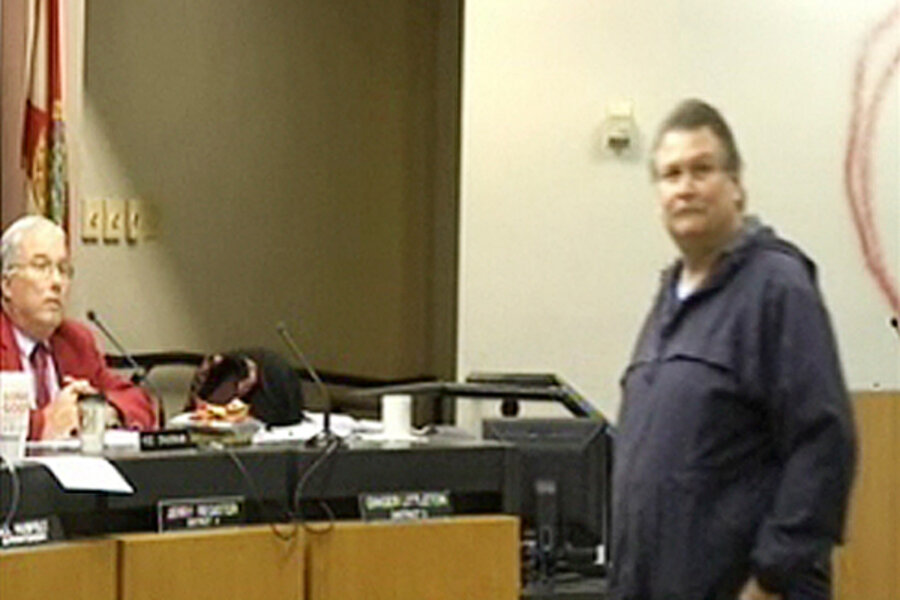Amid persisting economic duress, worries rise about suicides
Loading...
Economic hard times and corresponding financial duress among Americans appear to be taking a toll in the form of a modest increase in suicide, seen in several high-profile deaths this year. Some of the evidence is anecdotal, but it correlates with an uptick in the number of workplace suicides since 2007.
The apparent suicide of Tim Davlin, mayor of Springfield, Ill., whose body was discovered at his home Tuesday, and the case of Clay Duke, who in a hair-raising showdown fired on a school board in Panama City, Fla., Tuesday before taking his own life, are two of the latest cases in point. Mr. Davlin had been scheduled to appear in court to offer a financial accounting of a family estate for which he was executor, and he faced a federal tax lien of nearly $90,000 for unpaid income taxes. Mr. Duke told the school board he was angry that it had fired his wife earlier in the year, and his writings showed despondency over the wide income divide in the US.
The two cases punctuate another in February, when a man flew a small plane into a building in Austin, Texas, that housed an Internal Revenue Service office. The pilot, Joe Stack, blamed the government for his employment and business problems, having started companies that were later suspended by the state’s tax board.
Psychologists have long linked suicides to economic stresses such as unemployment or credit problems. The recent economic turmoil, in which many people have seen sliding home values, job loss, and evaporating savings, exacerbates the risk, says Nancy Zarse, an associate professor of clinical forensic psychology at The Chicago School of Professional Psychology.
“What is happening in the economy now is there is the pervasive sense there is no end in sight. We hear stories of good, qualified people out of work more than a year … and that perception can aggravate the hopelessness and helplessness of people,” says Dr. Zarse.
The longer the economic malaise lasts, she adds, the greater the potential that people experiencing financial hardship will perceive that their options are more limited.
“Before, if I lost my job I might think that I would get another one in three months and get back on my feet," she says. "Because of such desperate [economic] times [today], people are now afraid they may never be able to get their feet. It doesn’t have to be about reality, it’s about perception.”
Suicide is historically linked to economic downturns. The rate peaked in 1933, the height of the Great Depression, at 17.4 per 100,000 people, according to the American Association of Suicidology, which studies suicidal behavior and advocates prevention. That peak came one year after the US unemployment rate reached 25 percent, a stark contrast to the jobless rate of 0.04 percent just a few years earlier.
The suicide rate has never revisited that 1933 level, but it has increased this decade – from 10.7 per 100,000 people in 2000 to 11.5 in 2007, the last year tabulated by the Centers for Disease Control and Prevention. (Those latest figures predate the worst of the Great Recession.)
Suicides occurring in the workplace have definitely jumped during the Great Recession, from 196 in 2007 to 263 in 2008, the highest number ever reported by the National Census of Fatal Occupational Injuries. The number of workplace suicides dipped a bit to 237 in 2009.
Such public suicides occur when people feel a need to express their dissatisfaction about the issues that they feel drove them to take drastic measures, says Brad Bushman of Ohio State University in Columbus, who studies violence and suicide in the workplace.
Times of economic hardship include conditions that can be ripe for suicides, says Art Markman, a behavioral psychologist at the University of Texas in Austin. When people are confronted with situations that they feel are beyond their control, such as a recession, some may do whatever they can to seize ownership, he says.
“One thing that happens with recessions, on top of the stress, is the attempt to seize control of a situation. But the longer the stressful period goes, the harder it is for [the person] to control their behavior and regulate themselves,” Dr. Markman says.
Warning signs of suicide can be increased substance abuse or threats, says Zarse. For the person who may be experiencing economic-related stress, she says, the main objective is to regain a better sense of perception on the matter. Talking with others, either friends or a crisis hot line counseler, may help people in distress see their situation through a more hopeful lens.
The American Association of Suicidology also emphasizes that most crisis situations, including financial ones, are temporary. The organization cites studies involving Holocaust survivors to show that living through intense and difficult situations can actually strengthen family ties and personal beliefs.





